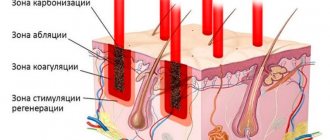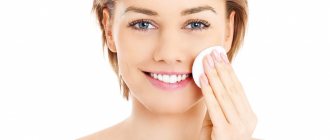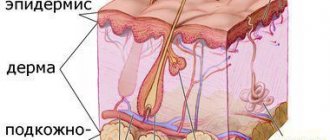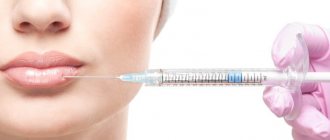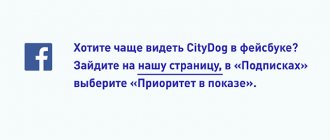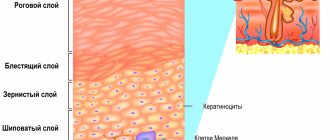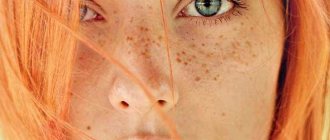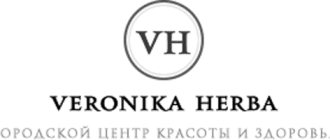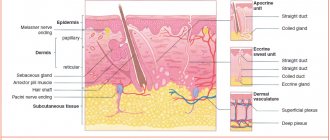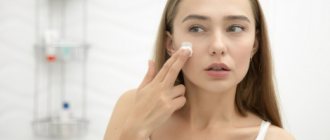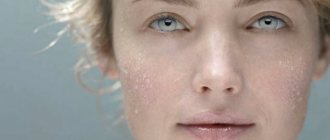The effectiveness of laser treatment on different types of scars varies. To eliminate deeper and more significant lesions, you need to contact the salon several times. Sessions help remove problems such as:
- post-acne;
- bites;
- burns of various origins;
- traces of surgery.
The device can be used on any part of the face or body. The work must be carried out by a professional cosmetologist.
Full recovery occurs in 5-7 days. In the first 3 days, the treatment site is not lubricated with creams, with the exception of those prescribed by the doctor. For 3 weeks, it is not recommended to apply peels or use scrubs to cleanse the skin. If crusts have formed, it is not advisable to remove them.
You need to abstain from sunbathing for a month and use protective equipment that protects you from exposure to UV rays.
Which is better – CO₂ or Er:YAG lasers? Practical advice from a cosmetologist
With increasing intensity of exposure, the heating temperature of the tissue increases, accompanied by the following processes:
- Stimulation of intracellular processes (37.5 – 39 °C)
- Protein denaturation and membrane destruction (at 40 – 45 °C)
- Coagulation and necrosis (60 °C)
- Dehydration (100 °C)
- Carbonation (150 °C)
- Vaporization (over 300 °C)
It is also worth emphasizing that the various thermal effects of laser radiation on tissue are never observed separately and are always present, however, the size of these zones depends on the wavelength of the laser system.
Rice. 1. Absorption curve | Rice. 2. Ablation zones and thermal effect (coagulation) zone: on the left side – Er:YAG, on the right side – CO2 |
CO2 laser systems have a wavelength of 10,600 nm, while erbium laser systems have a wavelength of 2940 nm, while the energy absorption coefficient of the chromophore (water molecule) for this laser system is 12,000 cm-1, for a CO2 laser - 800 cm-1 . This suggests that the wavelength emitted by the erbium laser is absorbed 12 to 15 times higher than that of CO2. This leads to a difference in the thermal effect, namely in the size of the coagulation zone.
Rice. 3. The coagulation zone on a CO2 laser is 100-160 microns (depending on the set parameters), the coagulation width on an erbium laser does not exceed 30 microns
A small zone of Er:YAG tissue coagulation allows minimizing the rehabilitation period with a good clinical effect.
In foreign studies 1998–2010. comparisons of the two laser systems were carried out on large groups of subjects. For example, in one study, patients aged 18 to 88 years with perioral and periorbital scars and involutive skin changes were selected. One half of the face was treated with a CO2 laser, the other with Er:YAG. The treatment method is continuous ablation. The effect was assessed 1 day, 7 days, 6 months after the procedure.
Rice. 4. Patient on the 1st day after laser resurfacing. Right side – CO2, left – Er:YAG. This patient was unable to open his right eye for 24 hours after the procedure due to swelling! | Rice. 5. The same patient 7 days after laser resurfacing. The side treated with the CO2 laser (right) continued to have erythema and swelling, unlike the side treated with the erbium laser | Rice. 6. Another patient 7 days after laser resurfacing. There is more pronounced swelling and hyperemia of the skin on the CO2-treated side (right), in contrast to the Er:YAG-treated left side |
Rice. 7. Skin biopsy (continuous laser resurfacing method): Left – Er:YAG, right – CO2
Rice. 8. Periorbital wrinkles. The left half of the face is Er:YAG, the right half of the face is CO2. Right photo – result 6 months after the procedure
Rice. 9. Oral wrinkles. The left half of the face is Er:YAG, the right half of the face is CO2. Right photo – result 6 months after the procedure
In a group of patients with involuting wrinkles of the periorbital and oral zones (age 65–80 years), positive dynamics were noted on both halves of the face, however, the lifting effect of deep skin wrinkles was better expressed on the side treated with a CO2 laser system.
Carbon dioxide (CO2) laser systems certainly make it possible to cope with a wide range of problems, especially when it comes to pronounced hypertrophic and post-acne scars of the skin due to a more pronounced thermal effect, which causes contracture of the protein due to a pronounced coagulation zone → expansion of the blood vessels of the dermis → release of pro-inflammatory cytokines → the beginning of fibrin retraction and polymerization → the start of neocollagenesis.
But what to do when it comes to atrophic skin scars?
After all, atrophic scars arise as a result of a reduced response of connective tissue to injury, as a result of which insufficient collagen is formed. The study by Tay and Kwok (2008) involved 150 volunteers with three types of atrophic scars: V-shaped, M-shaped, U-shaped, and compared the effectiveness of CO2 and erbium resurfacing when working with them. Patients who underwent erbium laser resurfacing showed improvement in U-shaped scars in 52.9% of cases, M-shaped scars in 43.1% of cases, V-shaped scars in 25.9% of cases, while As with the CO2 laser, there was a 23.3% improvement in U-shaped, 15% improved in M-shaped, 17.7% improved in V-shaped, and the erbium laser is now the standard in the treatment of atrophic skin scars.
Erbium lasers have now become the standard in the treatment of atrophic skin scars! In my medical practice, I use two laser systems:
- Eraser C-RF (CO2 laser, 10,600 nm)
- Lotus II (Er:YAG laser, 2940 nm)
The Eraser C-RF CO2 laser system has a wide range of parameters, which allows you to create individual protocols for each patient. Possibility of additional connection of gynecological and ENT instruments, without “upgrading” the device and without switching scanners. The Coherent tube (metal, double welded and vacuum) makes the laser system indefinite. A unique ability to work in stack mode (up to 50 stacks), forming an ordered factional zone in the “rain” mode by chaotic feeding in a stable mode. This function allows you to gently treat the area without the use of topical anesthesia.
Video of the CO2 laser resurfacing procedure using the Eraser-C-RF device
The modern erbium laser system Lotus II (LaserOptek, South Korea) allows for both “cold and ultra-cold” and “hot” laser grinding, close to CO2 laser systems. All this is possible thanks to the choice of pulse duration from ultra-short - 40 μs ("cold" grinding), with virtually no period of desocialization and rehabilitation ("weekend grinding"), to an ultra-long pulse with a duration of 5000 μs ("hot grinding"). Moreover, in addition to the registration certificate of Roszdravnadzor, the Lotus II device has FDA approval, which proves its widespread use in the US and European markets. The device has a number of advantages:
- Lens thermal compensator
- Flat beam profile
- Lamp life 10 million pulses
- The presence of several attachments for removing tumors, fractional resurfacing, a set of gynecological attachments
Video of the scar treatment procedure using the Lotus II laser system
Clinical cases
Rice. 10. Rejuvenation and elimination of post-acne scars using the CO2 Eraser C-RF device
Rice. 11. Elimination of stretch marks and atrophic scars using the Lotus II Er:YAG device
Conclusion
Due to the difference in wavelengths between the CO2 laser (10,600 nm) and Er:YAG (2,940 nm), the degree of absorption of laser energy by the water chromophore also differs. The energy emitted by an erbium laser is absorbed by the water chromophore 12-15 times more than that of a CO2 laser system, due to which we see completely different clinical effects. The CO2 laser copes with pronounced hypertrophic scars, deep involutional wrinkles, but almost always has a long period of desocialization and rehabilitation for the patient, while the erbium laser copes well with normal and atrophic skin scars, “face lifting”, age-related skin changes with short rehabilitation period.
In my practice, I use both laser systems (Eraser-C-RF and Lotus II), since they do not exclude, but complement each other and open up wide opportunities for solving many aesthetic problems!
Sources
- Khatri KA, Ross V, Grevelink JM, Magro CM, Anderson RR. Comparison of Erbium:YAG and Carbon Dioxide Lasers in Resurfacing of Facial Rhytides. Arch Dermatol. 1999;135(4):391–397. doi:10.1001/archderm.135.4.391
- Goldust M (2014) The efficacy and safety of Er:YAG laser for the treatment of atrophic acne scars, 1: DOI: 10.15761/GOD.1000116
- Tay YK, Kwok C (2008) Minimally ablative erbium:YAG laser resurfacing of facial atrophic acne scars in Asian skin: a pilot study. Dermatol Surg 34:681–685
- Hu S, Hsiao WC, Chen MC, Huang YL, Chang SL, et al. (2011) Ablative fractional erbium-doped yttrium aluminum garnet laser with coagulation mode for the treatment of atrophic acne scars in Asian skin. Dermatol Surg 37:939–944.
Author
Karmanchikov Vladimir Sergeevich - dermatovenerologist, cosmetologist, trichologist, laser therapist. Certified Clinical Trainer.
Laser skin resurfacing: pros and cons
The procedure is suitable for people of all ages. But you should not rush to make a decision, since this procedure is not suitable for everyone. You should definitely consult your doctor regarding contraindications and the choice of grinding method. If there are acute inflammations, fresh wounds, etc., grinding with a thermal beam is inappropriate.
The optimal time for skin resurfacing is autumn and winter. The reason is simple: thinner, sensitive skin after the procedure for at least six months is at increased risk of getting sunburned.
We guarantee the quality of laser scar resurfacing, affordable prices, and complete safety of the procedure!
Electrophoresis/Ultrasound
The Elfor Prof physiotherapeutic device is widely used in medical institutions - it has a wide range of indications and is highly effective. In addition to diseases of many systems and organs, the device is also used for cosmetic purposes. It increases tissue metabolism, eliminates toxic products, causes restoration of damaged skin, and normalizes functional ability.
Using the device, medicinal components that are responsible for tissue regeneration are delivered under the skin. The effectiveness of the procedure is achieved through the combined effect of weak current and medications that enter the body.
The operation of the device is associated with enhancing the effect of drugs due to the mobility of ions. In cosmetology it is used for:
- smoothing wrinkles;
- return of firmness and elasticity;
- cleansing and narrowing pores;
- getting rid of acne and its defective traces;
- skin lifting;
- seborrhea;
- alopecia;
- scar treatment.
To get rid of scars using the device, electrophoresis with lidase is used. Effective for removing young (less than 6 months) keloid and hypertrophic scars.
Subcision is the most effective remedy for acne scars on the face
The method is based on the subcision technique, which was developed by American dermatologist David S. Orentreich.
Treatment of acne scars in women and men involves cutting the connecting cords that fix the bottom of the scar and immerse it into the skin. The surgeon cuts the tissues, they are released and rise up, the skin is leveled.
This is a very delicate and painstaking work that requires the doctor to have knowledge, precision, concentration, patience and pedantry. Subcision is the only technique that affects the cause of skin unevenness and eliminates it. Other methods deal only with the investigation.
The drug Collost
These are injections with bovine collagen fibers, which, when introduced into the human body, increase the independent production of collagen. This increases tissue elasticity and activates the processes of regeneration of scars and wrinkles.
"Collost" copes well with stretch marks, traces of infectious rashes, acne and scars. A collostotherapy session is performed in a specialized cosmetology clinic by a highly qualified doctor.
The advantages of this type of rejuvenation and skin improvement are:
- safety;
- absence of injuries;
- no recovery period;
- long lasting effect after the first use.
To carry out each of the listed methods for improving the condition of the dermis, you must consult a doctor.
SkinLazerMed Medical Center invites you to attend a free consultation on the day of one of the procedures. Here you will be answered all your questions about the removal of scars, stretch marks, etc. Only certified devices are used. Prices for services provided are the most affordable among cosmetology clinics in St. Petersburg.
Contraindications
It is not recommended to do in the following cases:
- If you have skin diseases;
- During pregnancy;
- For chronic diseases;
- There is a possibility of keloid formation;
- If there is a problem with blood vessels and capillaries;
- For rashes on the face.
There are no other restrictions on the procedure; if all of the above has nothing to do with you, you can safely proceed to polishing. It requires a special approach; one cannot treat it with disdain.
Recommended viewing:
If for some reason you decide to do it yourself, carefully consider whether the result will be worth the risk. Carefully select the composition that suits your skin type and strictly follow the instructions, only in this case will you be able to achieve a positive result.
How does removing acne scars using Platinetal differ from other methods?
We devoted a separate article to what acne scars are, and why resurfacing will never solve the problem of post-acne, no matter how many times you do it.
In short, scars form in the lower, reticular layer of the skin. It is in this layer that elastin and collagen fibers are located and it determines how smooth our skin looks. Acne damages its structure. A scar forms at the site of damage.
Since scars form in the reticular layer of the skin, it is logical that this is what needs to be affected in order to smooth out the scar. This is the mistake: in the process of peeling, polishing and other procedures to eliminate scars, cosmetologists act only on the upper, papillary layer of the skin. But the problem was and remains the same, because, by and large, the doctor does not work with it at all.
We work with the lower, papillary layer of skin, where scars form, and eliminate them.
